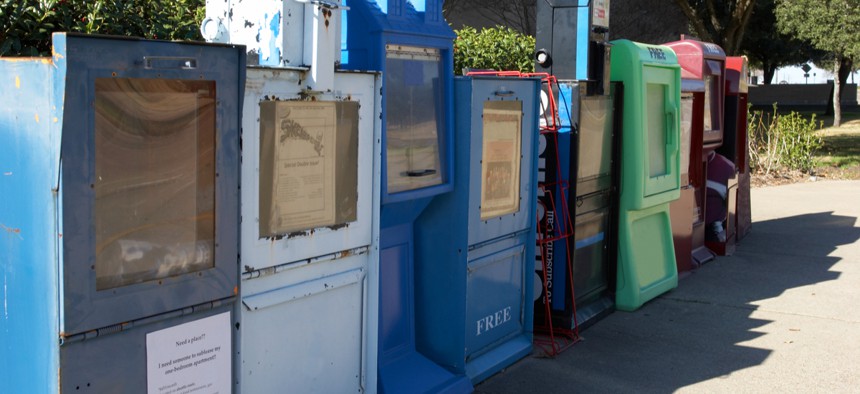Local News Is Dying, and Americans Have No Idea

Shutterstock
While the industry nose-dives, a large majority of the country thinks it is doing great.
Local news is in the midst of a long financial crisis, as newsrooms are hit with layoffs, page counts shrink, and entire papers go belly-up.
And yet Americans haven’t noticed. Seven in 10 Americans believe that their local news outlets are doing “very or somewhat well financially,” according to a new Pew Research survey.
This is, to put it mildly, a misapprehension.
The newspaper industry has been in a tailspin since internet companies ate the $5 billion in classified advertising they’d been raking in, and social media became an alternative entry point to the day’s news. Worse, the solution that saved the The New York Times—high-margin digital subscriptions—has not yet proved itself for smaller papers. Just 14 percent of Pew’s survey respondents said they had paid for local news in some way in the past year. Forty-nine percent of the people who didn’t pay cited the “widespread availability of free content” as their reason why, according to Pew.
Local radio—a few stations excepted—has been cannibalized by digital on-demand offerings. Free-distribution alternative newsweeklies—which often provided a substantial counterbalance to establishment papers, but never had a paying subscriber base to rely on—started losing business to Craigslist decades ago and never really recovered. Many have received their eulogies; others are attenuated and anemic.
Local television has proved a more resilient business. Despite viewership declines and the loss of deeper forms of reporting, the industry has only been very, very mildly contracting.
But newspaper reporters used to be the backbone of every local journalism ecosystem. Medium- and large-sized cities sometimes had hundreds of them, and their publications’ formats allowed for the day-to-day coverage and investigative explorations that make civic journalism valuable to communities.
In a previous world, perhaps one could imagine that a million bloggers would spring up to fill the void left by all the actual reporting jobs disappearing, but that clearly did not and is not going to happen. The explosion of national digital-only news outlets has come and gone. Many survive, but few do the kind of journalism that local papers did. It’s one thing to tweet from a city council meeting every once in a while, and a whole other thing to cover City Hall for a real newspaper.
There are bright, local, digital-only spots—say, the Voice of San Diego or Berkeleyside—but they are the exceptions, not the rule.
Add it all up and, according to a recent report, 1,300 communities have completely lost local news coverage.
In most places, the news still exists. The paper hits the doorstep. The radio breaks for updates. At 11 o’clock, someone starts talking on the TV about top stories.
But the loss of reporters and editors has hollowed out the coverage. There are fewer and less experienced reporters. Each paper covers a smaller chunk of the region, leading nearly half of Americans to say that their local news doesn’t actually cover their own local area. The editors don’t have a lifetime’s worth of knowledge of the places they’re working.
Golden-era newspaper journalism had many problems. For example, publishers like the Knowland family, which ran the Oakland Tribune, used their papers to help them maintain political power. Women and people of color were underrepresented in the journalistic ranks as well as in the pages. (There is a reason that black people developed an entirely separate set of journalistic institutions.)
Even so, as the local journalistic institutions have fallen, they have not been replaced by something better, but rather nothing at all. And as they die off, many Americans don’t even know it.
Alexis C. Madrigal is a staff writer at The Atlantic, which originally published this article.
NEXT STORY: Shelter Animals Become Official State Pets






